
Love at first sight is an occurrence not restricted to human beings. Every horse lover knows this particular moment when one sees a certain horse and immediately wants to own it. This moment happened to Eva-Maria (“Evi”) Pracht, daughter of the legendary dressage rider Dr. Josef Neckermann, in 1984.
Already emigrated to Canada, Evi and her husband, the late Hans Pracht, were briefly back in Germany visiting their friend Herbert Krug. This accomplished dressage rider was a winegrower by profession, but also traded a bit with dressage horses from Scandinavia at that time.
“We stood in the indoor arena and watched Herbert work a small chestnut horse. I immediately liked it, his face, his way of going. I told Herbert that this horse is much too small for him and how much better he would look like with me in the saddle,” the petite Evi recalled. But Krug, who won an Olympic team gold medal the same year on the Danish Warmblood gelding Muscadeur, did not intend to sell the 9-year old chestnut.
Evi’s husband sensed how much his wife had fallen in love with the gelding und told her to drive back to her parents’ house and leave the task of convincing Krug to him. Both men, who had been friends for years, went to a nearby pub and spent the evening with some glasses of beer.
“At 2 am my husband came back, slightly merry and told me he had bought the horse. He had made the deal on a coaster which I still own. Of course my night was over. I was too happy to fall asleep again,” Evi reminisced.
A horse without a proper name so far, without any show experience and hardly at M-level at age 9. Yet nothing could stop Evi from buying the horse, not even a failed pre-purchase exam due to a chip.
This special horse was Emirage, who Evi named after his sire Emir. The chestnut was born in 1975 and bred by Claes Ivarsson from Ängelholm in Sweden. His sire, also a chestnut, was by the legendary stallion and Olympic dressage horse Gaspari and he had been sold as a dressage prospect to the Linsenhoff stable. He competed up to S- level dressage. Krug had discovered Emirage at a most uncommon place when he saw him being hacked in a Swedish forest with an old man aboard. The valuable bloodlines convinced Krug to buy the horse and start working with him.
Gold Medal Winning Small Tour Horse
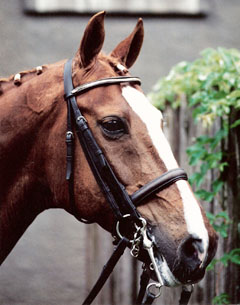 Although Emirage began serious dressage work at an age other horses already perform at Olympic Games, his cleverness and great working attitude enabled him to progress quite quickly. “When I took him to Canada he was able to do half passes and single flying changes.” Evi Pracht admitted that she prefers and loves riding horses who “have fire” and want to go forward above quieter horses that one has to push forward all the time.
Although Emirage began serious dressage work at an age other horses already perform at Olympic Games, his cleverness and great working attitude enabled him to progress quite quickly. “When I took him to Canada he was able to do half passes and single flying changes.” Evi Pracht admitted that she prefers and loves riding horses who “have fire” and want to go forward above quieter horses that one has to push forward all the time.
Her new acquisition soon proved to be exactly that. “Emirage was really really wild after he arrived in Canada. He bolted away with me and once even threw my husband off.” Evi persevered and upgraded the horse to Prix St. Georges level within reasonable time. Still in their first S- show the red-headed horse’s temperament shone through and caused some problems. Emirage was not keen on entering the arena, so Evi’s husband Hans hid in a bush and showed the horse a whip every time he refused to go in. They finally succeeded and he never looked back.
In 1986 the quite handsome gelding with striking white blaze like his ancestors became the Canadian dressage champion in the advanced division after several competitions at PSG during the season. He was also nominated on the official Canadian team competing in the small tour of the 1986 World Championships, held at Pracht’s impressive equestrian centre at Cedar Valley near Toronto. Emirage did the hostess proud by placed in the top three.
To claim Emirage was an easy horse from then on would not be true, but Evi loved him and her affection for him proved most important while training him up the levels. “I always do my best to make the horses my friends. They are not just animals I sit on, ride and give them back to the groom. That’s not me and it’s not the way to establish friendship with horses," Evi told Eurodressage. Every evening she went to the stables and gave every horses a treat and wished them good night. She even did that returning from visits to the opera or ballet in Toronto, though Evi then only intended to look for Emirage again before going to sleep. He would always recognise her footsteps and whinny loudly so that all the other horses awoke and then Evi felt urged to give treats to all of them instead of only to Emirage as intended.
In 1987 Emirage was a 12-year old experienced small tour horse when he travelled to the Pan American Games in Indianapolis, along with his stable mate Little Joe who was competed by Evi’s talented 23-year old daughter Martina. Mother and daughter were in the gold medal winning team along with individual winner Christilot Boylen on Epernay and Diana Billes on a horse called Lustig. Though Emirage’s successful team outing was a great achievement, the Pan American Games are only at PSG level and not necessarily an indicator for a horse that will be successful at the more demanding Grand Prix level.
The Struggle to Reach Grand Prix
 Emirage might have switched quicker to Grand Prix, but it took him about 12 months to learn the one time changes.
Emirage might have switched quicker to Grand Prix, but it took him about 12 months to learn the one time changes.
“I tried really hard, but whatever I did Emirage never showed more than two or three one time changes”. Evi was quite desperated, even more so when her father had flown to Canada and was not able to fix the problem. Emirage would not be the first talented dressage horse whose Grand Prix career never realised because of those vicious one tempis.
After a long struggle Evi discovered the proverbial right button: “One day I found out that I only had to take a bit stronger hold of the outer rein and Emirage would change. Immediately he showed 20 one-time changes. I stopped the horse, praised him, jumped off and ran to the house. There I hugged my husband and told him the fantastic news. It was wonderful, like Easter and Christmas at the same time,” Evi still happily recalls the day.
In the winter of 1987-1988 Evi took her horses and moved them for the first time to the much milder tropical climate of Florida, an annual commute she still does to this date. There she started her beloved horse’s Grand Prix campaign and Emirage enthused the judges and crowds from the beginning! He won the GP kur in Tampa and was also victorious in Palm Beach and Orlando, two important dressage shows of the Florida show circuit.
The Pan American gold medalist looked a serious Olympic contender when Evi returned home to Canada in April 1988. “I decided to give Emirage a well-earned break after he had worked so hard in Florida. I put him in the field and gave him only light work,” Evi reported.
For her it has always been important to allow her horses to calm down and relax. To Evi it is quite common in Canada to put sport horses in a field and for the sparkling Emirage “I used a special ‘tranquilliser’. We had a school horse, Pepper, which we had rescued from slaughter. He was a fabulous babysitter for Emirage. When he ran around Pepper just stood there like a statue and then Emirage always calmed down quickly.”
In hindsight Evi admitted it wasn’t the best idea to put Emirage on a break for such a while. At the first Olympic trial he reminded her of his early days, “bucking around and almost leaving the fenced arena. We ended up lower in the rankings.” Emirage managed to improve in the second trial and relieved his rider by even winning another one. Both were nominated for the Canadian Olympic squad. Evi’s 1984 Olympic mount Little Joe, in 1988 competed by her young daughter Martina, flew there as the team’s reserve horse.
Becoming an Olympian
 The Prachts' horses were accompanied by Alice Beaty, “the best groom I ever had, the best in the world." Alice had been Evi’s long-time groom in Canada and was already married in the USA when Evi asked her to groom Emirage in Seoul. “To fly with a horse, to look after it at Olympics Games needs an experienced and absolutely reliable groom and I hadn't such at that time. So I asked Alice and she agreed to take care of Emi. I would have never gone to Seoul without her," Evi stressed. Alice not only knew Emirage inside out, but also his rider. “At shows I wanted to have the stable as comfortable as at home. So I often cleaned the boxes, but Alice would always shout at me: ‘Stop it, Evi, this is my job. You are there for playing with the horses and training them. That’s what you are there for, the rest is my job"," Evi remembered.
The Prachts' horses were accompanied by Alice Beaty, “the best groom I ever had, the best in the world." Alice had been Evi’s long-time groom in Canada and was already married in the USA when Evi asked her to groom Emirage in Seoul. “To fly with a horse, to look after it at Olympics Games needs an experienced and absolutely reliable groom and I hadn't such at that time. So I asked Alice and she agreed to take care of Emi. I would have never gone to Seoul without her," Evi stressed. Alice not only knew Emirage inside out, but also his rider. “At shows I wanted to have the stable as comfortable as at home. So I often cleaned the boxes, but Alice would always shout at me: ‘Stop it, Evi, this is my job. You are there for playing with the horses and training them. That’s what you are there for, the rest is my job"," Evi remembered.
In Seoul nobody really considered Canada to have a serious medal winning chance, not even Evi: “A medal? Canada? No, never did I think we could have a chance.” As expected Cindy Ishoy and her fabulous Hanoverian gelding Dynasty scored highly, but also Gina Smith on the experienced Westfalian gelding Malte and the young Ashley Nicoll (today Holzer) with the so far unknown Swedish stallion Reipo (also by Emir) scored surprisingly high and placed in the top 20, all three qualifying for the individual final. Though Emirage was the drop score he had shown a reliable performance and Evi was very satisfied. “I was happy with him, he had given his very best!” One shouldn’t forget that Emirage was 13 then, but still not very experienced at Grand Prix level.
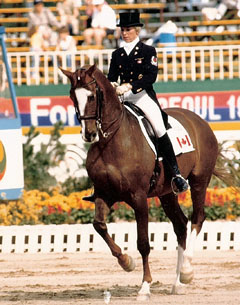 Sixteen years after Dr. Josef Neckermann had won his last Olympic medals, silver and bronze in Munich, his daughter had the honour to be member of a historical team, winning the first and so far only Olympic dressage medal for Canada. Standing on the podium with Emirage and his groom behind her, Evi recollected a memorable day earlier the year. “I had guests from Germany and we went to Yorkville, a lively part of Toronto, where there are several artists, street cafés and also fortune–tellers. One woman read my palm and told me I am going to do a long journey and that she sees something like a medal hanging around my neck. I forgot about it, but when I received the medal the thought came to my mind that this woman had been absolutely right," Evi reminisced.
Sixteen years after Dr. Josef Neckermann had won his last Olympic medals, silver and bronze in Munich, his daughter had the honour to be member of a historical team, winning the first and so far only Olympic dressage medal for Canada. Standing on the podium with Emirage and his groom behind her, Evi recollected a memorable day earlier the year. “I had guests from Germany and we went to Yorkville, a lively part of Toronto, where there are several artists, street cafés and also fortune–tellers. One woman read my palm and told me I am going to do a long journey and that she sees something like a medal hanging around my neck. I forgot about it, but when I received the medal the thought came to my mind that this woman had been absolutely right," Evi reminisced.
Medals are highly valued by most athletes and Evi was no exception. However riding Emirage to Olympic team bronze in Seoul meant something very special to her in another way as her father, suffering from blood poisoning, was there to share her Olympic moment. “At the medal ceremony Prof.Dr. Bertold Beitz told me I should come to my father on the tribune because he wasn’t able to come down to me due to his aching foot. I went to him and he had tears in his eyes. It touched me seeing him like that, it meant and still means incredibly much to me, because my father was a true perfectionist and I had never completely lived up to his high expectation until Seoul.”
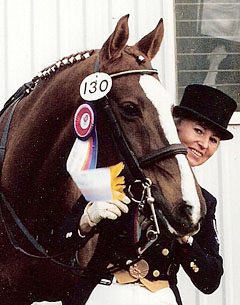 After his daughter had followed in his footsteps Neckermann confessed his hope that his grandchild Martina may follow in her mother’s Olympic footsteps in his best-selling biography “Im starken Trab." After a career lasting over three decades Evi probably had similar thoughts. She decided to hand Emirage over to her daughter after the 1990 World Cup final in which Evi represented Canada.
After his daughter had followed in his footsteps Neckermann confessed his hope that his grandchild Martina may follow in her mother’s Olympic footsteps in his best-selling biography “Im starken Trab." After a career lasting over three decades Evi probably had similar thoughts. She decided to hand Emirage over to her daughter after the 1990 World Cup final in which Evi represented Canada.
Pracht does have the happiest memories of the show. “I still don’t know why, but in s’Hertogenbosch Emirage was completely beside himself. He was uncontrollable. I thought he would climb up the walls of his box and I feared he might injure himself. Unfortunately he continued like that in the Grand Prix and finished last. While trying to present my horse as best as possible I saw my father sitting next to Princess Ann, vigorously shaking his head. That was the final blow for me,” Evi told Eurodressage.
Despite that unlucky show Emirage did a good 1990 season, winning the GP kur in Bloomfield and becoming the GP Champion of the Tournament of Cchampions at his home in Cedar Valley.
A Third Generation Following in Those Footsteps
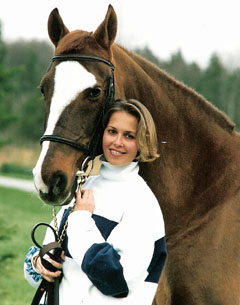 After that Evi handed the reins to her then 26-year old daughter Martina. Many young dressage riders would dream of having such an opportunity, but surprisingly Martina wasn’t that keen on riding her mother’s Olympic horse. “I told Martina she can ride Emirage and that he would give her the chance to compete internationally, even at the Olympics. But she did not like Emirage too much. Unlike me Martina prefers more quieter obedient horses rather than unpredictable ones like him. But I could convince her that she would be able to
After that Evi handed the reins to her then 26-year old daughter Martina. Many young dressage riders would dream of having such an opportunity, but surprisingly Martina wasn’t that keen on riding her mother’s Olympic horse. “I told Martina she can ride Emirage and that he would give her the chance to compete internationally, even at the Olympics. But she did not like Emirage too much. Unlike me Martina prefers more quieter obedient horses rather than unpredictable ones like him. But I could convince her that she would be able to
ride Emirage, which she actually could. But she never had the same relationship with him like me.”
Martina well remembers the time she took on the ride on Emirage. "My involvement with Emirage started in 1991, after my mother's retirement. He was her horse and was still fit and young enough to compete. My mother and Emirage had a very strong bond and were an awesome team together, and I really wasn't quite sure how the two of us would get along. At the time being, I was without a suitable Grand Prix mount, so we started to work together. Although Emi was rather little he was a feisty and challenging horse to ride.”
However Martina continued her mother’s success. She was able to control the “wild boy” very well. “We had a fairly good 1991 season, including several top ribbons at the Grand Prix level, highlighted with a second place finish at the Canadian Dressage Championships and Canadian World Cup Final," Martina recalled.
In 1992 the names “Pracht / Emirage” were again found on the Olympic starters' list after both had shown reliable performances at the Canadian Olympic trials. Martina had actually followed in her mother’s footsteps, though sadly neither her father nor her grandfather still lived to see the third generation of the family at the greatest sport event in the world. Both had passed away a year earlier. Alice Beaty again came back from her “retirement” and groomed Emirage once more.
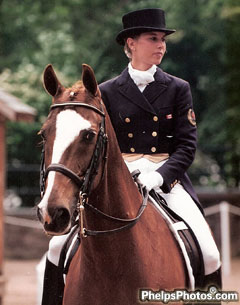 This time the Canadian team had no chance of a medal, even though Christilot Boylen had a good young horse called Biraldo. But Cindy Ishoy had lost her great Dynasty only a year after Seoul and Leonie Bramall’s talented Oldenburg mare Gilbona failed the vet-check so Canada had no drop score. Martina summarized the experience as following. “Going to the Olympic Games had always been a dream of mine and Emirage made that possible. Barcelona, however, was a disappointing adventure, since both Emi and myself weren't well at the time and the results spoke for themselves.” Martina and Emirage may not have won an Olympic medal, but with their start in Spain Emirage achieved something unique and so far unequalled: He is the only horse ever carrying two generations of the same family at an Olympic Games.
This time the Canadian team had no chance of a medal, even though Christilot Boylen had a good young horse called Biraldo. But Cindy Ishoy had lost her great Dynasty only a year after Seoul and Leonie Bramall’s talented Oldenburg mare Gilbona failed the vet-check so Canada had no drop score. Martina summarized the experience as following. “Going to the Olympic Games had always been a dream of mine and Emirage made that possible. Barcelona, however, was a disappointing adventure, since both Emi and myself weren't well at the time and the results spoke for themselves.” Martina and Emirage may not have won an Olympic medal, but with their start in Spain Emirage achieved something unique and so far unequalled: He is the only horse ever carrying two generations of the same family at an Olympic Games.
Barcelona was not the end of Emirage's career. Even at 18 “Emi,” as he was affectionately called by his ladies, was fit and made Martina the Canadian Grand Prix Champion in 1993 before retiring a year later.
A long Happy Retirement
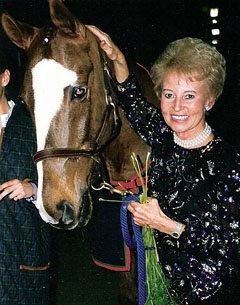 Of course a horse like Emirage got a very special farewell ceremony at the legendary Royal Winter Fair in Toronto in 1994. It was also special because another Canadian equine hero attended it, another chestnut with an extraordinary story: Big Ben, Ian Millar’s three time Olympic jumping horse, double winner of the World Cup and a living legend in Canada.
Of course a horse like Emirage got a very special farewell ceremony at the legendary Royal Winter Fair in Toronto in 1994. It was also special because another Canadian equine hero attended it, another chestnut with an extraordinary story: Big Ben, Ian Millar’s three time Olympic jumping horse, double winner of the World Cup and a living legend in Canada.
Two chestnuts that did Canada proud on the international stage said goodbye to the public. It was also the end of Martina and Emi's partnership. “In closing, I have to say, that I was very grateful to have had the experience with Emirage, even if we couldn't quite match the chemistry he and my Mother had." Emirage got the retirement he truly deserved. He went out in the field with one of his baby-sitters, either Pepper (who became 35 at Pracht’s stable!) or an American Miniature Horse, Marilyn, who is still with Evi and who was the first pony of her grandchild Sabrina.
Evi hacked Emirage daily, often having her horse’s friend, the pony, at a lead rein. Very special pupils were allowed to learn the Grand Prix movements on the wise professor. Being over 20 Emirage returned into the limelight one last time. Evi had choreographed a quadrille with 10 horses for the Royal Winter Fair and when one girl needed a horse she was allowed to participate on Emirage. Emirage also gave delight to some young children and teenagers who desperately wanted to do piaffe once in their lifetimes. Evi had taught Emirage to do piaffe when she clicked and so these children proudly “rode” a piaffe on the old campaigner.
 Even as an old horse Emirage continued to be “the cheapest horse concerning veterinary bills I ever had”. Not a day in his long life the cheeky little Swede with the charming white eyelashes was unsound. “He was sound all his life. He didn’t need bandages or something like that in the stables. He had clear legs until the end. Only once he gave me a fright when he was a bit unsound at one hind leg after a vaccination. But my vet laughed at me and told me a muscle ached because of the injection. The next day Emirage was his old self again," Evi reported.
Even as an old horse Emirage continued to be “the cheapest horse concerning veterinary bills I ever had”. Not a day in his long life the cheeky little Swede with the charming white eyelashes was unsound. “He was sound all his life. He didn’t need bandages or something like that in the stables. He had clear legs until the end. Only once he gave me a fright when he was a bit unsound at one hind leg after a vaccination. But my vet laughed at me and told me a muscle ached because of the injection. The next day Emirage was his old self again," Evi reported.
In 1999 Emirage was 24 and his life was threatened by a horrible reaction to an immune vaccination which, according to Evi, also affected Big Ben. Soon Emirage had 42 ° C fever and was horribly sick. In the equine hospital they diagnosed lung damage and told Evi she could never ride Emirage again.
Evi took him home and took all precautions like feeding wet hay and treating him with an inhalator. In her despair she also tried something unconventional. She talked to a woman who was an expert in the healing power of crystals and this woman gave Evi some special ones for Emirage. So Evi put crystals under his blanket and in his water bucket as well as in the bucket where the hay was soaked for 24 hours. Obviously the crystals together with the other treatment did the trick, because some months later Evi took him to the hospital again for a check up and to vets' amazement Emirage was completely cured.
“Emi” was then regularly ridden again until his 26th year and he enjoyed his exercise.
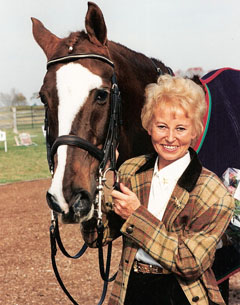 In 2002 Emirage was 27 and Evi was away in her old home country Germany when his condition deteriorated. She phoned home every day, but her daughter could only give her bad news every time. The old horse didn’t eat and drink properly and showed lung problems.
In 2002 Emirage was 27 and Evi was away in her old home country Germany when his condition deteriorated. She phoned home every day, but her daughter could only give her bad news every time. The old horse didn’t eat and drink properly and showed lung problems.
Evi flew home and found her faithful friend of so many years suffering. Even in this state Emirage was enthusiastic seeing his beloved Evi again as if he had been waiting for her return.
The next day Evi and her daughter decided to have him put down to sleep. It was the end of an era. For 17 years Emirage had accompanied Evi on her path in life. “I have loved all my horses and it’s hard to say which one meant the most to me. Horses were my friends, I have lived with them, played with them. Emirage was my last Grand Prix horse and he stayed with me exceptionally long. Like for all my other horses, such as Mazepa, Little Joe, Duccas, Antoinette, Cantate and Lyogen I feel love and friendship forever as I did for him. I have a deep gratefulness for having had all of them in my life.”
Article by Silke Rottermann for Eurodressage.com
Photos © Private - Cealy Tetley - Phelpsphotos.com
Don't forget to follow us on Facebook and Twitter for more exclusive dressage updates
Related Links
Antoinette, Josef Neckermann's Prima Donna
Dynasty, A Horse Who Lived Up To His Name